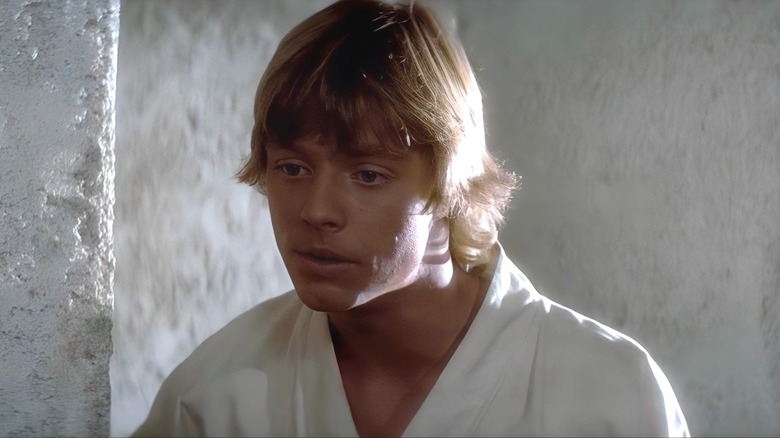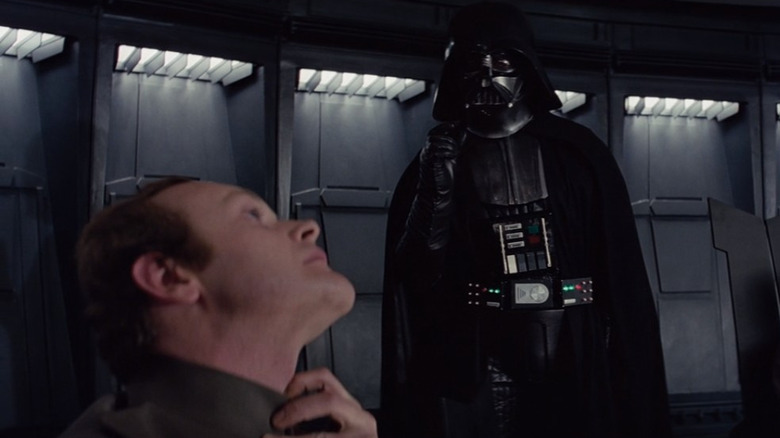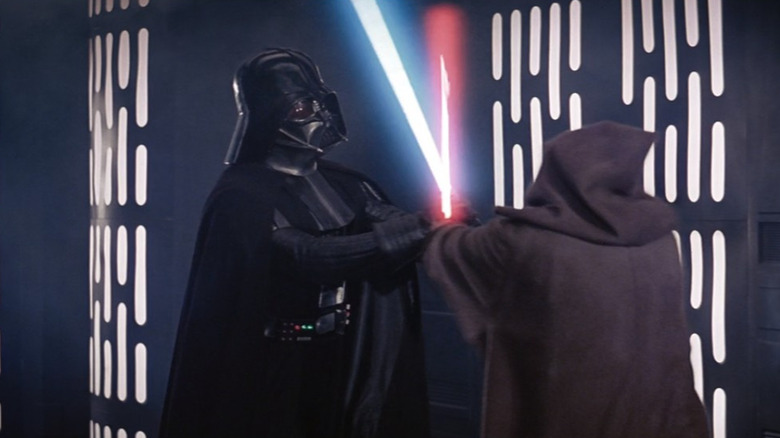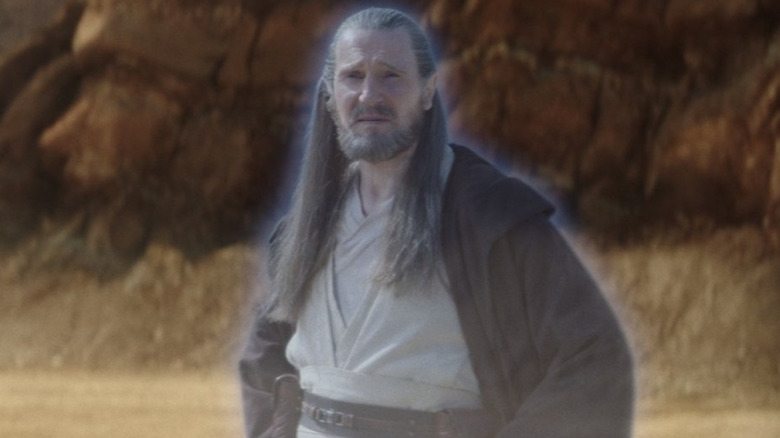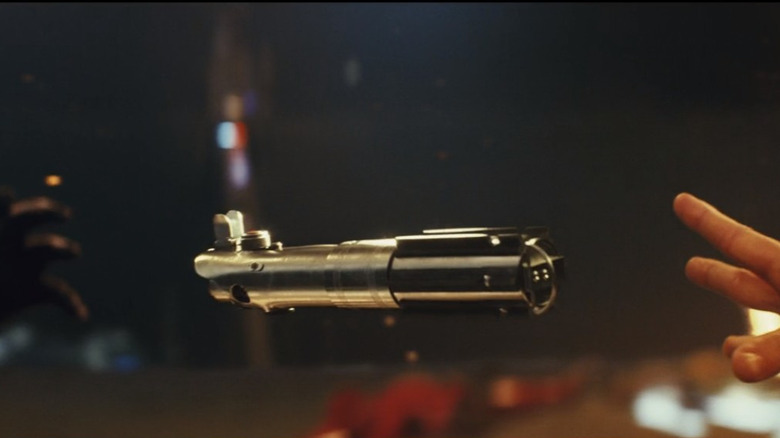Star Wars: 4 Facts About The Force That Make No Sense
While "Star Wars" may be about the struggle between a tyrannical empire and a scrappy rebellion told from the perspective of a young boy searching for his place in the universe, it is about so much more. Of course, the surface-level struggle between the warring governmental entities is apparent; it serves as a backdrop to a more profound struggle between good and evil and the Jedi and Sith's use of the Force. This aspect became the main attraction to "Star Wars," but it also has a few characteristics that make little sense — things like midi-chlorians and even the light and dark sides.
As fans, we have poured over every medium that presents the Force to try and understand it since it first arrived in "Star Wars: A New Hope" decades ago. Some updates made it more fun, like the Expanded Universe delving deep into the history, and some updates filled us with confusion, such as Anakin Skywalker having been conceived by the Force itself, suggesting that it is a living and conscious entity. But it seems to mostly be a movable target to allow for deeper storylines and more intriguing character story arcs, even if that approach causes some inconsistencies.
Of course, some of these moments of confusion can be chalked up to continuity errors or adjustments to make a current project feel more appropriate at the moment or flow more freely. Still, "Star Wars" fans struggle with confusing inconsistencies, and we don't let things like these go easily.
Midi-chlorians contradict George Lucas
In "Star Wars: A New Hope," multiple people call the Force a religion. Once to Darth Vader (David Prowse/James Earl Jones) when sitting in the situation room on the Death Star, and once by Han Solo (Harrison Ford) on the Millenium Falcon while Luke Skywalker (Mark Hamill) is attempting to learn how to wield it. Years later, when the prequel trilogy reignited the franchise, Qui-Gon Jinn (Liam Neeson) introduced the concept of midi-chlorians when testing young Anakin (Jake Lloyd).
This caused some blowback in the fanbase because it changed the entire concept of the Force for the future. In an interview during a story conference (as reported by Gizmodo), George Lucas revealed that anyone can learn the ways of the Force. He likened it to learning yoga or karate. If you want to learn it, you can work hard and become adept in the ways of the Force. He also revealed that Yoda (Frank Oz) and other Jedi Masters are different from Jedi Knights because they are teachers more than warriors and wouldn't do much in an actual fight.
Taking that into account, it brings the question, what is the purpose of the midi-chlorians? If Han Solo wanted to focus on the Force and learn the ways of the Jedi, it seems the number of midi-chlorians in the bloodstream serves no purpose other than determining the strength of the Force within someone. Reddit user u/le_fez chimed in on a thread discussing the viability of the concept, writing, "The problem most people I know have with it is that it turns the Jedi from a cross between samurai and Shao Lin monks into the X-Men." This statement contradicts Lucas' comments.
Do the light and dark sides really exist?
The primary conflict surrounding the Force is the struggle between the Jedi and the Sith, respectively representing the light and the dark side of the Force. But do those distinctions really make sense? Like many aspects (politics, religion, etc.), the moral compass is in the hands of the user. So does the Force actually have a light and dark side, or is it simply a collection of people using the living force in the same way for the same goal?
One explanation of this idea is presented in a Reddit thread by u/Whitepill-rescue. After describing how Darth Plagueis became a Force ghost after Darth Sidious killed him, giving him exactly what he wanted in achieving immortality, they wrote, "What this means is that Darth Plagueis was so well practiced in the Force, so attuned, so studied, so wise, that he broke through the dark side of the force and the petty divide between light and dark, realizing the oneness of the force, achieving full knowledge in it and ultimately became one with it. Far from being just a failed Sith Lord, Darth Plagueis was the first enlightened Jedi."
The idea that there is no true light or dark side of the Force, and the only way to master it is to master yourself, also explains the story arc of Darth Vader. While he made the choice to go to the dark side and embraced evil, he ultimately redeemed himself by destroying his master and returning to the light. The argument can be made that he became the chosen one only after he mastered both the light and the dark, bringing true balance in dispelling the squabble between the two.
What's the deal with the Force ghosts?
Force ghosts are a conundrum, as they can be inconsistent in terms of how they are used by one side. For instance, Jedis are the only ones shown to use them in films and series. While some Expanded Universe instances of Sith use similar techniques, it is largely a power used by Jedi, similar to how Force lightning is associated with the Sith. But some instances genuinely don't make sense in the main film continuity.
Qui-Gon Jinn seems to have been the Jedi that rediscovered the talent and taught it to Yoda and the younger Obi-Wan (Ewan McGregor) after his death. But when he died, his body remained, as did Anakin's, while Yoda, Obi-Wan, and Luke all disappeared upon dying to become one with the Force. All of those instances also show wildly different iterations of the Force ghosts. For instance, Obi-Wan (Alec Guinness) offered little more than guidance to Luke in the original trilogy, while Luke was able to project a Force ghost all the way across the galaxy and engage in a battle before his death. That talent would have been helpful to the young and inexperienced Luke in his early confrontations.
There are also inconsistencies in the appearance of the ghosts. In almost every instance, the blue apparitions looked like they did at the time of their death. However, at the end of "Return of the Jedi," Anakin appeared as his young self — someone Luke wouldn't likely recognize.
The Force is the ultimate plot device
The truth about the Force is that it is frankly the ultimate plot device. It exists in everyone, but only some can feel it. It is a religion but also a genetic predisposition. There are some incredible inconsistencies with the powers that are used and the collective flightiness of the existence of said powers. And what all of that comes down to is what makes it a good story and what can push the plot forward.
One of the biggest inconsistencies is in the use of some of the most powerful abilities. For instance, the Thought Bomb is a powerful weapon that could destroy all Force sensitives instantly if put to proper use. There should have been at least a few attempts to create one instead of trying to build a fleet of ships and Death Stars and then trying the exact same plan after it failed the first time. Darth Vader spent his entire existence in the service of the Emperor, and we have seen his ability to catch a ship mid-air. Yet, we never see the Emperor do more than Force lightning and manipulate a government, something anyone with enough money could do.
There is also the problem of Force healing, used by Kylo Ren (Adam Driver) to save Rey (Daisy Ridley) when she was mortally wounded. That would have come in handy multiple times, especially to save Qui-Gon and during Order 66. The only way to explain these inconsistencies is that writers needed to pick and choose which to use to propel a story forward and which to omit to keep the story engaging. Both of these created Death Star-sized holes in the portrayal of the Force.
